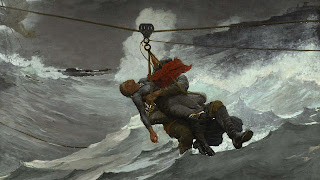Friday, September 28, 2012
Why You Shouldn’t Believe the “Earlier Mona Lisa” Hype
Labels:
Big Think,
Critics,
Da Vinci (Leonardo),
Kemp (Martin),
Louvre,
Raphael
Tuesday, September 25, 2012
Rescuing the Importance of Winslow Homer’s Life Line
In our current “War on Terror,” it’s sometimes hard to imagine or appreciate the terrors of times gone by. For Americans of the 19th century, stories of shipwrecks struck deep into their souls. Many harbored fresh memories of a harrowing crossing to the New World from Europe. Tales of rescue efforts that were too little, too late, or both filled newspapers and raised public ire. In the response to this uproar, the U.S. Government legislated in 1878 the development of a network of coastal life-saving stations called the Live-Saving Service. Six years later, Winslow Homer painted The Life Line, a celebration of these rescuing heroes that made Homer famous almost overnight and that still captures viewers’ imaginations today. Shipwreck! Winslow Homer and “The Life Line”, which runs at the Philadelphia Museum of Art through December 16, 2012, rescues the importance of this stirring picture not just as a great artistic achievement but also as a snapshot of a moment in time when heroes won their war on the terror of the seas. Please come over to Picture This at Big Think to read more of "Rescuing the Importance of Winslow Homer’s Life Line."
[Image: Winslow Homer,
American, 1836-1910. The
Life Line, 1884. Oil on canvas, 28 5/8 x
44 3/4 inches (72.7 x 113.7 cm). Philadelphia Museum of Art, The George W.
Elkins Collection, 1924.]
[Many thanks to the Philadelphia Museum of Art for the image above, an invitation to the press release for, and press materials related to Shipwreck! Winslow Homer and “The Life Line”, which runs through December 16, 2012.]
Sunday, September 23, 2012
What Would Warhol Do?
“They always say time changes things,” Andy Warhol once said, “but you actually have to change them yourself.” Warhol simultaneously embodied and changed his time—a combination that continues to work posthumously through artists working today. In a new exhibition at The Metropolitan Museum of Art titled Regarding Warhol: Sixty Artists, Fifty Years, the inheritors of Warhol’s legacy gather around to assess what hath Andy wraught for the past half century or so. In addition to being a great primer on Warhol’s art, Regarding Warhol acts as a whirlwind tour not just of what artists have done since the early 1960s, but also just how prevalent Warhol’s influence has been beyond the official art world. Regarding Warhol proves once and for all that it’s still Warhol’s world, and that we’re all just living and creating in it. Please come over to Picture This at Big Think to read more of "What Would Warhol Do?"
[Image: Andy
Warhol. Self-Portrait (detail),
1967. Acrylic and silkscreen on canvas.]
[Many thanks to The Metropolitan Museum of Art for providing me with the image above and other press materials related to the exhibition Regarding Warhol: Sixty Artists, Fifty Years, which runs through December 31, 2012. Many thanks also to Yale University Press for providing me with a review copy of the catalog to the exhibition.]
Subscribe to:
Posts (Atom)






